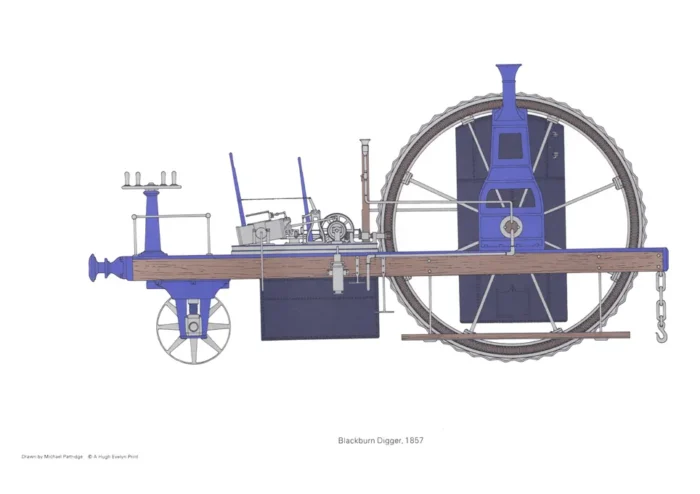Blackburn Digger, 1857
£20.00
Blackburn Digger, 1857 (scroll down for a more detailed Description)
Published 1969 by © Hugh Evelyn Limited; drawn by Michael Partridge
Size: 34 x 23 cm [13½″ x 9½″] may vary slightly from printers’ cut 50 years ago
Printed on high white matt heavy paper of 138 g/m2
Print is STANDARD size – shipping is the same for 1 to 10 prints (based on largest print size in your order) – see Shipping & Returns
In stock
Description
By the beginning of the 19th Century rollers were being used increasingly in the cultivation of green crops, where soil had to be reduced to a finer texture than the plough or harrow could achieve. Rollers varied in size and shape, usually of iron weighted with stones. They could be plain or spiked. A miniature model, weighing about 6 cwt, existed and these were useful for the lighter tasks of rolling sown ridged crops. Clod crushers looked like rollers but had sharp serrated rims which cut and broke clods before crushing. The Cambridge crusher had several iron discs revolving independently on an axle which penetrated to good effect on heavy clay. An outstanding original cultivating machine was that evolved by Blackburns of Derby. This 7-ton machine had a huge corrugated drum for crushing clods. A harrow drawn at the rear broke the soil further. The chassis comprised great wooden beams and the 6 feet wide drum was made of ½ inch thick steel plate. A vertical boiler set within the drum supplied steam to the engine cylinders. It was steered by a horizontal hand wheel mounted on the footplate above a small fore-carriage. The machine had a bearing load per square inch less than that of a horse’s hoof (according to the manufacturer’s marketing material). As a crusher it could only treat 40 acres a day and half this with a harrow attached. Six specially constructed ploughs could be attached and hauled at 3 mph. When unburdened the machine could reach 6 mph.
Additional information
| Weight | 0.0118 kg |
|---|---|
| Dimensions | 35 × 24.5 cm |

 Ransomes Four-Furrow 'Key-Conqueror' Disc Plough, 1919
Ransomes Four-Furrow 'Key-Conqueror' Disc Plough, 1919 


